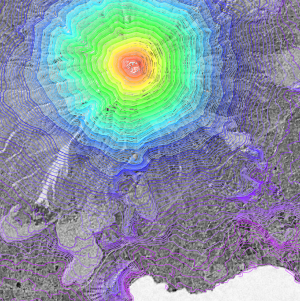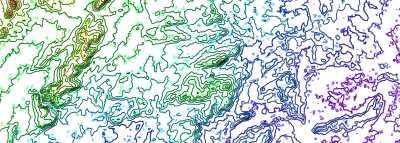Shuttle Radar Topography Mission: Difference between revisions
m (→External Links) |
|||
| (21 intermediate revisions by 2 users not shown) | |||
| Line 1: | Line 1: | ||
[[Category: Online Data]][[Category: Digital Elevation Models]] | [[Category: Online Data]][[Category: Digital Elevation Models]] | ||
== Introduction == | == Introduction == | ||
[[File:Endaevour.jpg|right|thumb| | [[File:Endaevour.jpg|right|thumb|300px|NASA image of Endeavour taking off on its STS-99 mission]]The Shuttle Radar Topography Mission (SRTM) data originate from an 11-day mission flown by the space shuttle Endeavour back in February 2000, on its [http://en.wikipedia.org/wiki/STS-99 STS-99] mission. The raw data were collected using an instrument named “Spaceborne Imaging Radar-C”. The raw data were later processed and released as usable digital grid files. | ||
=== Dataset Overview === | |||
* '''Spatial Coverage:''' Near global - coverage is most of land bodies on earth between degrees 60N and 56S (see image to the right). About 80% of the total landmass of the Earth is mapped by the STRM data, covering all land between 56 degrees south and 60 degrees northern latitude. A view of the data coverage is shown in the figure ro the right. The coverage is the same in both the 1 arc-second (30 m) and the 3 arc-second (90 m) data as currently distributed from windPRO. | |||
* '''Resolution:''' 1 arc-second (approximately 30m) and 3-arc-seconds (approximately 90 m). Regions above 50N and 50S are at 2 arc-second by 1 arc-second resolution. | |||
* '''Data-type:''' [[:Category%3ADigital_Elevation_Models#What_type_of_elevation_model.3F_DEM.2C_DSM_and_DTM.3F|Digital Surface Model (DSM)]] | |||
* '''Coordinate system (horizontal):''' Geographic WGS (EPSG:4326) | |||
* '''Coordinate system (vertical):''' EGM96 geoid | |||
* '''Version:''' 3.0 | |||
* '''Vertical Accuracy:''' | |||
** 16 m absolute error at 90% confidence (world wide) | |||
** Root Mean Square Error (RMSE) of 9.73 m (world-wide) | |||
== Availability from within WindPRO == | == Availability from within WindPRO == | ||
[[File:ExampleSRTM.png| | [[File:SRTMCoverage.png|right|300px|thumb|Near-global coverage of the SRTM dataset]][[File:ExampleSRTM.png|right|thumb|300px|Satellite Image with DEM Overlay. The image shows a part of the Ometepe Island in Lake Nicaragua with SRTM height contour data.]]The data are available directly from within WindPRO. The data can be accessed from the online-services in the following objects: | ||
1. Line Object (with purpose to height contour lines)<br> | |||
2. Elevation Grid Object | |||
In addition to loading the data directly from the EMD online services, WindPRO also supports importing the original *.hgt files that can also be downloaded from other internet sources. | In addition to loading the data directly from the EMD online services, WindPRO also supports importing the original *.hgt files that can also be downloaded from other internet sources. | ||
| Line 14: | Line 25: | ||
The SRTM data are delivered as gridded data with a spatial resolution of the dataset corresponding to 1 arc second and 3 arc seconds, i.e. approximately 30 m and 90 m distance between grid points. As a part of the processing of the SRTM data from our EMD server, the user has an option of choosing whether the data downloaded should be received as either raw gridded data or converted to height contour lines. In order to use the data for energy yield calculations, the data must be converted to contours. | The SRTM data are delivered as gridded data with a spatial resolution of the dataset corresponding to 1 arc second and 3 arc seconds, i.e. approximately 30 m and 90 m distance between grid points. As a part of the processing of the SRTM data from our EMD server, the user has an option of choosing whether the data downloaded should be received as either raw gridded data or converted to height contour lines. In order to use the data for energy yield calculations, the data must be converted to contours. | ||
The original SRTM data are stored as tiles sized 1 degree x 1 degree. | The original SRTM data are stored as tiles sized 1 degree x 1 degree. Please note that tiles above 50° north and below 50° south latitude are sampled at a resolution of 2 arc-second by 1 arc-second. | ||
== Versions and Data Sources == | == Versions and Data Sources == | ||
[[Image:3ArcVs1ArcSecondSRTM.png|thumb| | [[Image:3ArcVs1ArcSecondSRTM.png|thumb|400px|right|SRTM 1 arc-second (colored lines) and 3 arc-second data (black line) for a site in Egypt.]]Different versions of the SRTM data exist; at EMD we currently distribute the STRM data version 3. The difference between various versions is primarily that more error checking and validation is applied at later versions. | ||
The 1 arc-second and 3 arc-second dataset is available in windPRO 3.0 and later. | In 2014-2015, a 1 arc-second resolution dataset (30 m grid resolution) were made available in the near-global coverage (same coverage as the 3 arc-second dataset). This dataset is now also available in windPRO - in addition to the original dataset in a 3 arc-second resolution (90 m grid resolution). The 1 arc-second and 3 arc-second dataset is available in windPRO 3.0 and later versions. | ||
== | == Recommendation == | ||
Our experience with the 1 arc-second dataset shows that this 1-arc-second data does have a higher noise-to-information ratio as compared to the original 3-arc-second dataset. For wind energy applications, EMD recommendends using the 1-arc-second dataset over the 3-arc-second one. | |||
== Acknowledgement == | == Acknowledgement == | ||
NASA, team around STS-99 and the US public are thanked for making this great digital elevation dataset available in the public domain and thus for aiding the development of renewable energy. | NASA, team around STS-99 and the US public are thanked for making this great digital elevation dataset available in the public domain and thus for aiding the development of renewable energy. | ||
== External Links == | |||
[[File:SRTMNorthernIreland.png|right|350px|thumb|SRTM data in Northern Ireland: Left: As Height Contours, Right: As Gridded Data.]] | |||
* Original data are available from the NASA website - [http://www2.jpl.nasa.gov/srtm here]. | |||
* More information on SRTM is available at wikipedia - [http://en.wikipedia.org/wiki/Shuttle_Radar_Topography_Mission here]. | |||
* Direct download of 1° x 1° hgt.zip files at USGS - [http://dds.cr.usgs.gov/srtm/version2_1/SRTM3/ here]. | |||
* Direct download of 1° x 1° 1-arc second files at earth-explorer [http://earthexplorer.usgs.gov here]. | |||
Latest revision as of 13:39, 24 June 2020
Introduction

The Shuttle Radar Topography Mission (SRTM) data originate from an 11-day mission flown by the space shuttle Endeavour back in February 2000, on its STS-99 mission. The raw data were collected using an instrument named “Spaceborne Imaging Radar-C”. The raw data were later processed and released as usable digital grid files.
Dataset Overview
- Spatial Coverage: Near global - coverage is most of land bodies on earth between degrees 60N and 56S (see image to the right). About 80% of the total landmass of the Earth is mapped by the STRM data, covering all land between 56 degrees south and 60 degrees northern latitude. A view of the data coverage is shown in the figure ro the right. The coverage is the same in both the 1 arc-second (30 m) and the 3 arc-second (90 m) data as currently distributed from windPRO.
- Resolution: 1 arc-second (approximately 30m) and 3-arc-seconds (approximately 90 m). Regions above 50N and 50S are at 2 arc-second by 1 arc-second resolution.
- Data-type: Digital Surface Model (DSM)
- Coordinate system (horizontal): Geographic WGS (EPSG:4326)
- Coordinate system (vertical): EGM96 geoid
- Version: 3.0
- Vertical Accuracy:
- 16 m absolute error at 90% confidence (world wide)
- Root Mean Square Error (RMSE) of 9.73 m (world-wide)
Availability from within WindPRO


The data are available directly from within WindPRO. The data can be accessed from the online-services in the following objects:
1. Line Object (with purpose to height contour lines)
2. Elevation Grid Object
In addition to loading the data directly from the EMD online services, WindPRO also supports importing the original *.hgt files that can also be downloaded from other internet sources.
Data Type
The SRTM data are delivered as gridded data with a spatial resolution of the dataset corresponding to 1 arc second and 3 arc seconds, i.e. approximately 30 m and 90 m distance between grid points. As a part of the processing of the SRTM data from our EMD server, the user has an option of choosing whether the data downloaded should be received as either raw gridded data or converted to height contour lines. In order to use the data for energy yield calculations, the data must be converted to contours.
The original SRTM data are stored as tiles sized 1 degree x 1 degree. Please note that tiles above 50° north and below 50° south latitude are sampled at a resolution of 2 arc-second by 1 arc-second.
Versions and Data Sources

Different versions of the SRTM data exist; at EMD we currently distribute the STRM data version 3. The difference between various versions is primarily that more error checking and validation is applied at later versions.
In 2014-2015, a 1 arc-second resolution dataset (30 m grid resolution) were made available in the near-global coverage (same coverage as the 3 arc-second dataset). This dataset is now also available in windPRO - in addition to the original dataset in a 3 arc-second resolution (90 m grid resolution). The 1 arc-second and 3 arc-second dataset is available in windPRO 3.0 and later versions.
Recommendation
Our experience with the 1 arc-second dataset shows that this 1-arc-second data does have a higher noise-to-information ratio as compared to the original 3-arc-second dataset. For wind energy applications, EMD recommendends using the 1-arc-second dataset over the 3-arc-second one.
Acknowledgement
NASA, team around STS-99 and the US public are thanked for making this great digital elevation dataset available in the public domain and thus for aiding the development of renewable energy.
External Links
